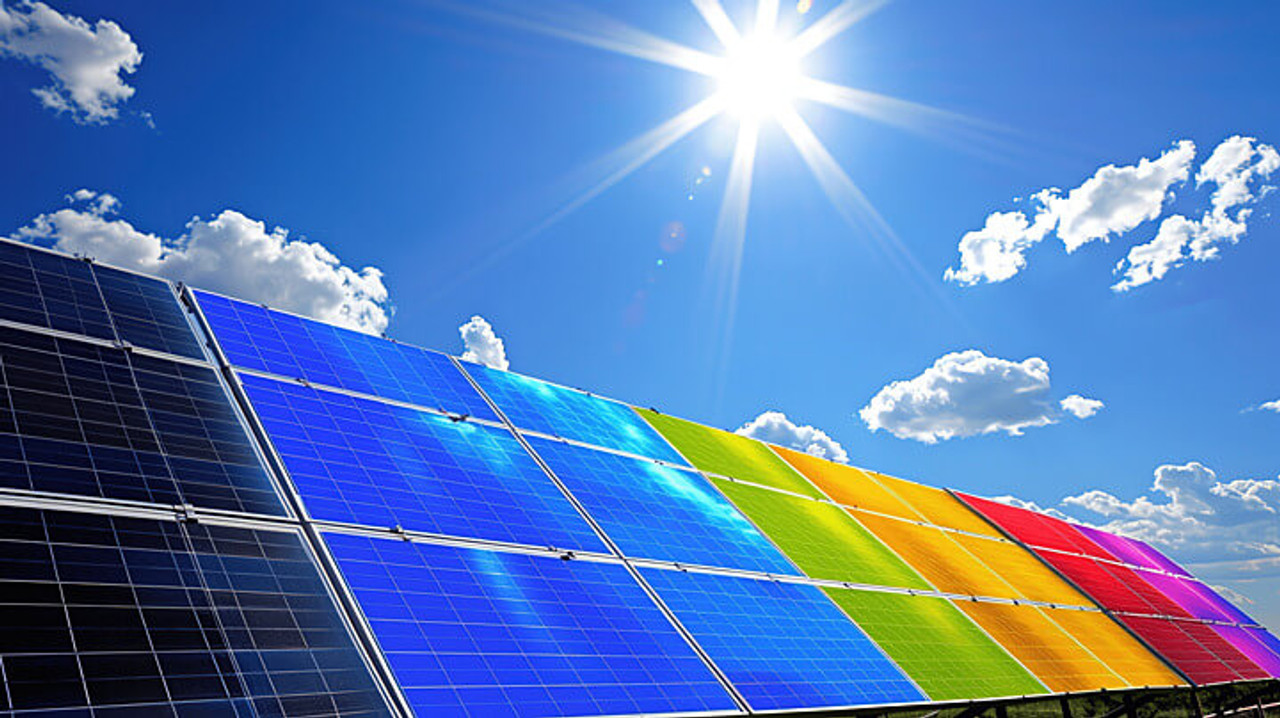Colored Solar Panels: Does the Color of Solar Panels Matter?
When choosing solar panels, most people focus on efficiency and cost, but one often overlooked factor is color. The color of solar panels affects more than just their appearance—it can influence how they perform and how well they fit with your home or business aesthetic. While black and blue panels are most common, new colored solar panels are emerging, offering more options for design-conscious consumers.
In this article, we'll explore whether the color of solar panels really matters. We'll cover how different colors impact energy efficiency, their performance in varying climates, and how to balance style with functionality. If you're considering colored solar panels, understanding how they affect both appearance and performance is key to making the right choice.
Can solar panels be different colors?
Yes, solar panels can come in different colors, although black and blue are the most common due to their high efficiency. Colored solar panels are now available, offering a wider range of options for those who want panels to blend with their roof or building design. However, the trade-off is that colored panels typically produce slightly less energy.
According to research from the National Renewable Energy Laboratory (NREL), colored solar panels can be about 10-20% less efficient than traditional black or blue panels. This is because darker colors absorb more sunlight, converting it into electricity more effectively.
Despite this, many homeowners and businesses are choosing colored panels for their aesthetic appeal, especially in areas where building codes or personal preferences prioritize design. With advancing technology, manufacturers are working on improving the efficiency of colored panels without sacrificing visual appeal.
Why are Most Solar Panels Black and Blue?
The color of solar panels plays a role in how much sunlight they absorb. Darker panels, particularly black ones, absorb more sunlight, which can lead to higher energy efficiency. Black panels are typically made from monocrystalline silicon, known for their superior efficiency in converting sunlight into electricity. Their dark color allows them to capture a wider spectrum of light, especially under direct sunlight.
The type of silicon (polycrystalline) used in some solar panels causes them to be blue. The blue tint is primarily owing to an anti-reflective coating, which improves the solar panels' absorption capacity and efficiency.
How efficient are colored solar panels?
The traditional blue or black panels may not always blend well with architectural aesthetics. This has led to the development of colored solar panels. But how do these visually appealing alternatives measure up in terms of efficiency?

How color affects energy absorption
The efficiency of solar panels is closely tied to their ability to absorb light across the visible spectrum. When we introduce color to solar panels, we inherently change their light absorption properties:
- Reflection vs. Absorption: Colored panels reflect certain wavelengths of light to produce the desired color. This reflected light is essentially lost energy that could have been converted to electricity.
- Spectral Selectivity: Different colors absorb and reflect different parts of the light spectrum. For instance, red panels absorb more red light but reflect other colors, potentially reducing overall energy absorption.
- Surface Treatments: The methods used to color panels, such as coatings or structural coloration, can introduce additional layers that light must pass through, potentially reducing the amount of light reaching the photovoltaic cells.
Energy production: reaching up to
The energy production of colored solar panels varies depending on the color and technology used:
- High-Efficiency Colored Panels: The best colored solar panels can reach up to 85-95% of the efficiency of standard panels. This means that if a traditional panel produces 100 watts, a high-efficiency colored panel might produce 85-95 watts under the same conditions.
- Standard Colored Panels: More common colored panels typically reach 70-80% of standard panel efficiency.
- Light-Colored or White Panels: These can see more significant reductions, sometimes producing only 55-65% of what a standard panel would generate.
Is color a major factor in efficiency?
Though color influences absorption, panel type (monocrystalline vs. polycrystalline) and quality have a greater impact on overall efficiency than color alone.
Impact of Solar Panel Color on Climate and Environment
The color of solar panels can influence both local climate effects and environmental impact. Darker panels, such as those in black or dark blue, absorb more sunlight, which can lead to a slight increase in heat around the panels. This localized warming effect, while generally minimal, can contribute to the urban heat island effect in densely populated areas.
On the other hand, lighter-colored panels reflect more sunlight, potentially reducing the surrounding temperature. This can be advantageous in hot climates where reducing heat absorption is beneficial. Studies suggest that reflective, lighter-colored panels can help mitigate some heat absorption, contributing to slightly cooler surroundings.
From an environmental perspective, the production of colored panels often involves additional materials and processes that might have a higher environmental footprint compared to standard black or blue panels. However, advancements in technology are improving the sustainability of colored panels, making them a more eco-friendly option.
Aesthetic considerations in solar panel color
When selecting solar panels, aesthetic considerations are as important as performance. The color of solar panels can significantly influence the overall look of homes and commercial buildings, playing a key role in architectural integration.
Architectural integration
The color choice of solar panels can enhance or detract from the architectural design of a structure. For contemporary homes and modern commercial buildings, black panels offer a sleek, minimalist appearance that seamlessly blends with various roof types and facades. This subtle integration can maintain the building's clean lines and sophisticated look.
Matching solar panels with roofs or building design
Homeowners and designers often choose solar panel colors to match or contrast with their roof or building design. Black panels are popular for their uniform appearance and ability to blend with dark roofing materials, contributing to a streamlined, cohesive look. Conversely, blue panels can stand out more, adding a pop of color that can be visually striking against lighter or more traditional roof colors.
Choosing the right solar panel color allows for customization that complements architectural styles while ensuring the panels enhance, rather than detract from, the building's overall aesthetic.
The future of colored solar panels
The future of colored solar panels is set to bring transformative changes, combining improved aesthetics with enhanced performance. As interest in personalized and visually appealing solar solutions grows, technological advancements are driving significant progress in this field.
Technological advancements
Recent innovations are making colored solar panels more efficient. For instance, research from the National Renewable Energy Laboratory (NREL) has shown that new materials and advanced coatings can maintain high energy conversion rates while offering a range of colors. Companies like Tesla have introduced solar roof tiles that not only blend seamlessly with existing roofing but also achieve efficiency close to traditional panels. This marks a significant step towards integrating aesthetics with functionality.
Design flexibility
Architectural trends are increasingly favoring unique and personalized designs. For example, the Danish firm K2S Architects has incorporated colored solar panels into their projects to complement the building's design, offering a more harmonious appearance. Additionally, technologies like solar skins allow homeowners to customize the look of their panels, further enhancing design flexibility.
Environmental impact
Sustainability is a key focus for the future of colored solar panels. Companies are investing in eco-friendly production methods and recyclable materials. For example, SunPower is working on reducing the environmental impact of their solar panels by improving material efficiency and recycling processes.
Conclusion
The aesthetic appeal of colored solar panels may be alluring to those with historical or otherwise unique buildings, but in most cases, the tradeoffs are not currently worth the investment. Traditional black panels, made from high-quality monocrystalline silicon, are highly efficient and durable, lasting 30 to 40 years. However, they can be more expensive and energy-intensive to produce.
Blue panels, made from polycrystalline silicon, are generally more affordable and easier to manufacture, with a lifespan of 20 to 25 years. They offer a cost-effective option but may have slightly lower efficiency.
Renogy is at the forefront of providing innovative solar solutions that cater to both style and function. As the demand for customizable and sustainable solar panels increases, Renogy is committed to delivering high-quality, eco-friendly options that meet diverse aesthetic and performance needs. Their advanced technology ensures that you can choose panels that align with your environmental goals and design preferences.
FAQs
Does solar panel color affect efficiency?
Solar panel color can influence efficiency, but it's not the primary factor. Darker panels, like black ones, typically absorb more heat, which can slightly boost energy absorption. However, overall efficiency is more dependent on the panel type, quality, and installation. For most users, the difference in efficiency due to color is minimal compared to other performance factors.
Can I get solar panels in custom colors?
Yes, custom-colored solar panels are available but are less common and usually more expensive. They are often used for specific architectural designs or branding purposes. While standard colors like black and blue are widely used for their efficiency and cost-effectiveness, custom options allow for unique designs but may not always offer the same performance benefits as traditional panels.
Which color solar panel is best for homes?
For homes, black solar panels are often preferred due to their sleek, modern look and slightly higher efficiency, especially in sunny areas. Blue panels, commonly used for their cost-effectiveness, are a good choice if aesthetics are less critical. Ultimately, the best color depends on your aesthetic preferences and whether you prioritize a clean appearance or cost savings.










